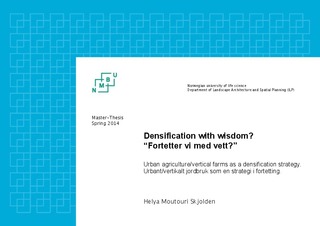| dc.description.abstract | Projects attempting to implement densification according to national guidelines have resulted in varying success in terms of economical, social and environmental sustainability. Global food production is under pressure by the growing world population. This has repercussions for Norway as well, seeing a rise in food prices as demand increases, as well as putting strain on the local environment and biodiversity.
This thesis discusses how urban and vertical farming can help bridge the efficient use of land and good quality urban environments while providing potential benefits in the three areas of sustainability. Specifically: How can we facilitate and implement Vertical farms in Norwegian context? Why do we need to include vertical/urban farming?
Firstly, a generalized approach, relying largely on literature review, is used to introduce densification and its connection to sustainability, as well as the possible introduction of vertical farming as a strategic tool in densification. Interviews supplement material on vertical farms worldwide, its potentials and planning issues and project implementation. Analysis of this material provides the foundation for studying a specific area and situation, in Breivoll (Oslo, Norway), and is investigated according to criteria of sustainability in relation to vertical farming.
In large part criteria for community-wide sustainability, inspired by Butters refers to in Haas (2012), and different methods and technologies of vertical farming are used as variables. Economic variables have received less attention and should be investigated in greater depth.
Findings indicate that the widespread implementation of vertical farming to a large degree may help reduce land use. Using volume to produce food rather than area will save space, but the cost efficiency in relation to traditional agriculture is uncertain, at least locally, and in the short term. This has long-term world-wide implications if practical knowledge and expertise are acquired and the proper combination of processes and support systems are incorporated to achieve maximum environmental, social and economic efficiency. In the short-term, it is expected that transformed buildings and warehouses will serve as testing grounds for urban agriculture and vertical farming. | nb_NO |
